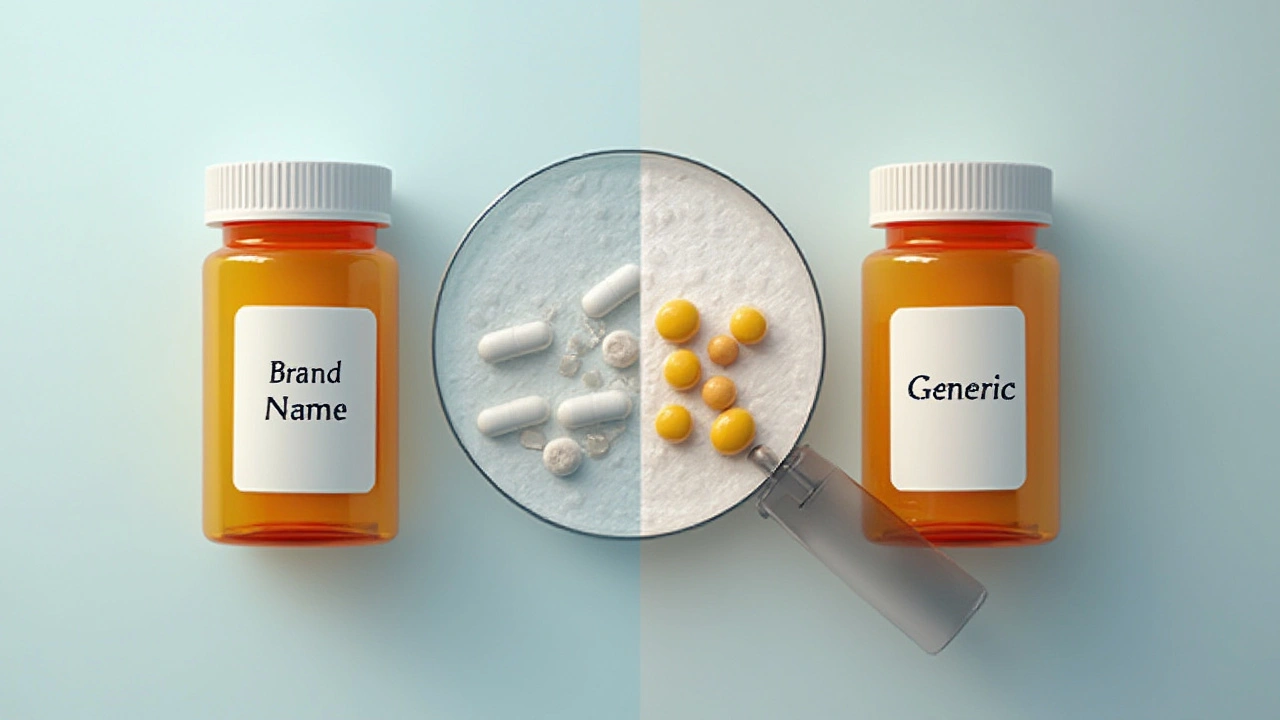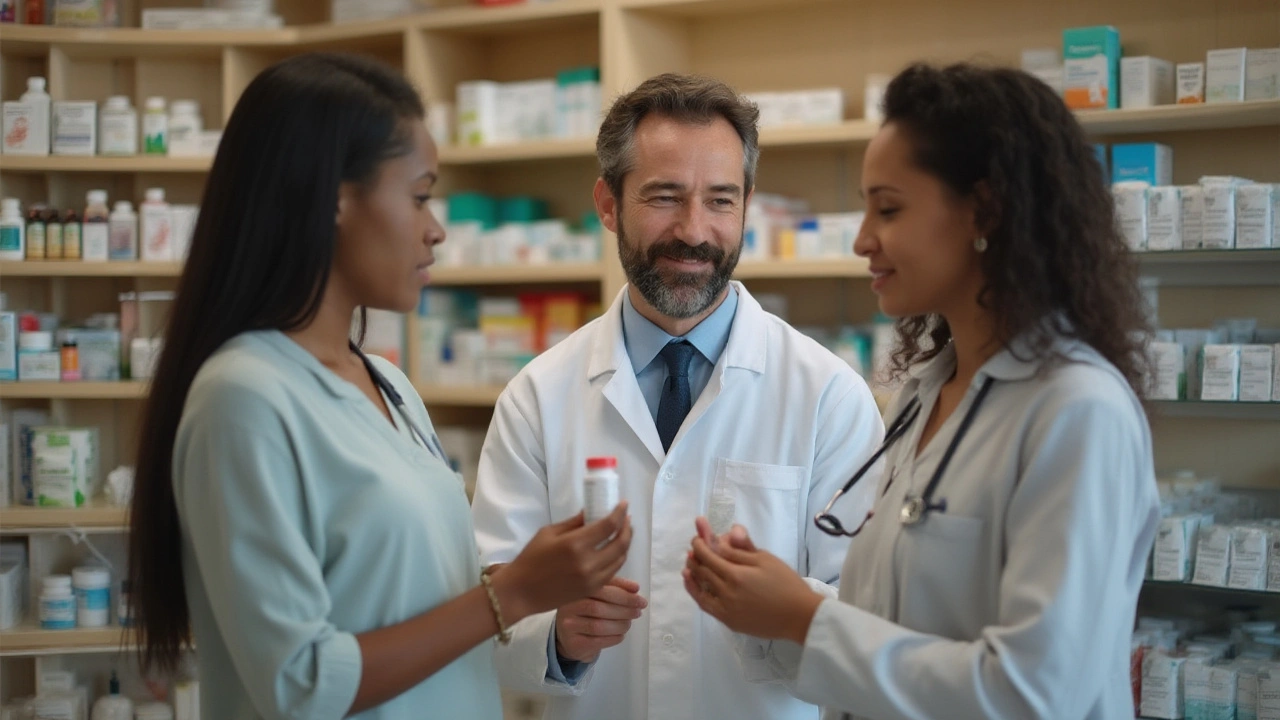It’s a little wild if you think about it: The prescription drugs in your medicine cabinet could have cost someone else hundreds more… or less. Two people, same bottle, wildly different bills. Why? Sometimes it all depends on knowing when to swap one drug for another—“substitution” in pharmacy talk, and it’s bigger than you might expect.
Understanding Drug Substitution: What Really Counts?
Switching out a prescription for its equivalent isn’t as simple as picking the cheaper bottle from the shelf. There’s science, safety, law, and money all rolled into this pharmacy puzzle. At heart, drug substitution is about swapping one medication for another that’s expected to have the same clinical effect. The classic example: trading brand-name Lipitor for generic atorvastatin to chop down cholesterol—and a big chunk of the cost. But it’s more than just brands and generics. Pharmacists sometimes substitute therapeutically equivalent meds (like swapping one blood pressure pill for another in the same class) if your insurance won’t cover the original. Drug substitution gets a lot of attention in 2025, as prices keep rising at double the general inflation rate per the American Medical Association’s most recent review. Yet, a Medscape survey this year found over 65% of U.S. patients aren’t sure exactly when it’s okay to substitute medications or what that means for their health.
Let’s pin down the basics. Generics are probably the most common substitutes. They’re required by the FDA to have the same active ingredient, strength, dosage form, and route of administration as their brand-name counterparts. In other words, generic sertraline is supposed to work like Zoloft. Yet, excipients (those extra ingredients like colorants, binders, or fillers) can differ. Most people won’t notice a difference, but some—maybe with allergies or sensitivities—might need the brand. Beyond generics, there are “therapeutic equivalents,” which aren’t identical, but treat the same condition in pretty much the same way. Pharmacists might suggest a switch if insurance restricts coverage, a shortage hits, or if your doctor writes “brand medically necessary”—which in New York, by law, they must explain on your prescription if you really need the original.
A quick quiz in 18 New York pharmacies this spring found 83% of substitutions had to do with insurance forcing the pharmacy’s hand. Only 9% came from doctors proactively choosing a new equivalent themselves. That means, often, your pharmacist is in the driver’s seat. Still, no reputable pharmacy will make a change without telling you—at least, not since several big chains faced lawsuits in the early 2020s for quietly filling generics overseas with unexpected differences.
It’s also good to know—not all drugs can be swapped. Think about medications with very narrow therapeutic ranges, like anti-epileptics or thyroid meds. Even slight changes in how your body absorbs them can lead to problems. The FDA classifies these as “NTI” (Narrow Therapeutic Index). In those cases, doctors and pharmacists tread very carefully, sometimes only allowing substitutions after extra blood level checks or monitoring. As recently as late last year, New York’s Department of Health sent out reminders to prescribers about never switching these unless absolutely necessary.
What about the global scene? While the U.S. has some of the world’s strictest substitution rules, drug shortages are nudging more countries to loosen up substitution laws. The European Medicines Agency, for instance, now lists more than 1200 drugs approved for substitution across the EU. Japan began fast-tracking generic approvals in 2024 to fight aging population costs. Each country has its quirks, so never assume your foreign-bought generic matches your U.S. one, especially if you travel for work or pleasure. Surprised? Most New Yorkers are, too—until they’re handed a little white pill that looks totally different than they’re used to.

The Science and Safety Behind Substituting Medications
Some stories stick with you. Take the Staten Island mom who, after a routine pharmacy switch, noticed her son’s seizure medication changed shape and suddenly he started experiencing more frequent episodes. The culprit: a generic version manufactured in another country with a barely different absorption rate. Her case made headlines locally and kicked off a big debate—how close does "equivalent" have to be for safety?
Technically, the FDA says a generic must show “bioequivalence”—meaning it delivers the main ingredient into your bloodstream at nearly the same speed and amount as the original. The leeway? Blood levels must stay within 80% to 125% of the reference drug's absorption. For the average adult, that’s fine. For someone with a tight medication window (think anti-rejection drugs after a transplant), a 10% swing could be risky. Here’s where the advice from pharmacists matters: ask questions if your medicine looks, tastes, or acts different. They’re required in New York and most states to flag substitutions with a sticker or note on the bag. Yet, a Columbia University survey last year found 37% of patients don’t read pharmacy notifications, partly because those labels can be small or filled with unfamiliar terms.
Let’s bust a myth: cheaper doesn’t mean lower quality. Generic drugs go through random batch testing, and out-of-spec lots are pulled. Since 2017, the FDA has run a public dashboard tracking every generic recall. According to 2024’s latest data, less than 1% of generics approved since 2012 have been recalled for quality failures in the U.S. So, statistically, that blue-capped bottle from an unknown brand on your shelf is just as solid as its name-brand cousin. Of course, pharmacy chains also have their preferred suppliers. In New York City, you’re more likely to get generics from Sandoz or Amneal, while in smaller towns, you might see Mylan or Cipla labels.
Sure, some patients really are “brand loyal”—either by necessity or just peace of mind. Pediatricians are often careful with kids on ADHD medications, sometimes sticking strictly to the original brand if parents report behavioral changes after a switch. That’s totally valid. But with cholesterol drugs like simvastatin or common blood pressure meds, most healthy adults do perfectly well on the generic equivalent. One Mount Sinai family practice doc put it bluntly: “If you trust your pharmacist, you’re probably fine with the swap 99% of the time.”
Below is a snapshot of some common substitutions and how tightly their safe ranges are managed. Keep in mind, New York’s rules generally mirror the FDA’s:
| Drug Type | Can Substitute? | Extra Precautions? |
|---|---|---|
| Statins (cholesterol) | Yes | No, unless allergies |
| Levothyroxine (thyroid) | Usually | Blood tests on switch |
| Antiepileptics | Sometimes | Close monitoring |
| SSRIs (antidepressants) | Yes | No |
| Insulins | Rarely | Doctor guidance only |
Smart tip: Next time a pharmacist hands you a new drug, do a quick once-over—does the pill, bottle, and label look familiar? Got a new color, shape, or taste? Ask about it. Pharmacy mistakes are rare (around 0.02% in NY per the state’s 2023 audit) but not impossible. Many chains now use AI-driven scanners to double-check fills. Yet, nothing beats your own watchful eye. Some tech-forward pharmacies even text photos of your dispensed pills before you pick them up. That means less guesswork, and fewer awkward moments at the counter. Speaking of awkward—don’t be shy about asking if a substitute was used. It’s your health. You’re the top boss.

Practical Tips and Real-Life Considerations For Safe Drug Substitution
Here’s where things get really personal. Maybe you’re staring at a new script, or your insurance just switched pharmacy plans and suddenly the total at checkout makes your stomach drop. Or maybe your doctor scribbled “DAW” on your prescription (“Dispense as Written,” which blocks substitution, unless overridden). What should you actually do?
Start with your pharmacist—they’re the real MVP here. Ask if the new medicine performs identically, and if there’s any reason not to substitute. If your insurance requires it and the swap is safe, you could save a bundle. According to the 2024 Kaiser Family Foundation report, generic substitution can trim pharmacy costs by up to 85%. That’s not pocket change. For families on several meds, the savings run hundreds per year. If you’re on a tight budget or worried about a specific generic, see if there’s a manufacturer you trust—most New York pharmacies will try to order your preferred brand if you ask ahead. Just don’t wait until day-of pickup for special requests—supply chain hiccups happen, especially during holidays or big storms closing shipping routes.
Let’s get real: sometimes the swap isn’t about price, but about allergy risk. Those tiny white fillers, dyes, and binders matter if you have celiac disease, lactose intolerance, or known dye allergies. Some generics use lactose as a filler, others skip it. Always flag known allergies every time, even if you think they’re marked in your file—pharmacies process thousands of scripts a day, and double-checking helps avoid mix-ups. Same goes for dietary preferences: vegetarians/vegans, kosher, or halal patients should always ask about capsule and tablet sources. You can even get ingredient printouts at most major chains now.
If you’re on a drug with a narrow therapeutic window (again—think anti-epileptics, thyroid, or transplant meds), talk to your prescribing doctor before approving a swap. We’re talking about situations where a 5% dose change really matters. Most good NYC clinics have in-house pharmacists for these trickier meds. If yours doesn’t, ask them to call your regular pharmacy and talk it out together. New York state insurance plans usually cover brand-name versions for these critical-use drugs if your doc calls in what’s called a “prior authorization.” It’s a bit of paperwork but can mean life-changing stability.
During drug shortages, things change. Pharmacists might offer a therapeutic equivalent—not the FDA-approved generic, but a drug in the same class that works similarly. In spring 2024, a huge Ozempic supply crunch meant a lot more New Yorkers with type 2 diabetes were switched to Trulicity or even insulin temporarily. The American Diabetes Association now recommends regular blood sugar checks whenever these kinds of substitutions happen. If you ever get a new med in a crisis (like an ER visit when your usual supply is wiped out), double-check what you’re given as soon as you’re able.
- Compare the description of the new pill or bottle on the pharmacy handout to what’s in your bag—it should match up every time.
- Download a reputable pill identifier app if you’re unsure. Most urgent care clinics in NYC recommend Medscape’s or Drugs.com’s tools.
- Keep a medication journal, noting each time your prescription changes manufacturer, shape, or color—especially for sensitive drugs.
- If you feel side effects or new symptoms after a pharmacy switch (even minor ones), call your doctor or pharmacist right away—don’t just wait it out.
One last heads-up for travelers: if you fill your script outside the U.S., double-check FDA equivalence lists or ask your pharmacy back home to review what you get. According to the World Health Organization, up to 10% of global medications may be counterfeit or subpar, especially online. Never buy Rx drugs from unknown online sources—even if the price is tempting. In New York, state law lets you ask your pharmacy for a country-of-origin printout for any medication, and starting this summer, new QR codes will be required on labels for transparency. More peace of mind, right?
Drug substitution—it sounds technical, but it’s really about making sure you’re safe, covered, and not throwing away money. You’ve got more power than you think, just by asking questions and keeping your eyes open. Next time you’re at the pharmacy and wondering if that swap is okay, remember: knowledge truly is the best medicine.


Write a comment